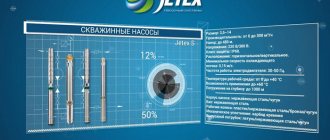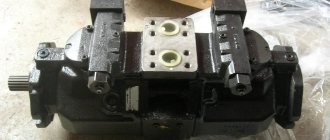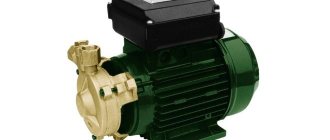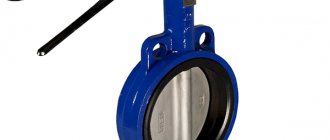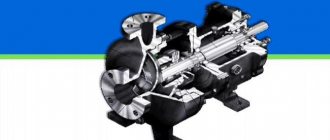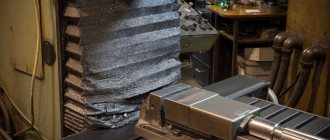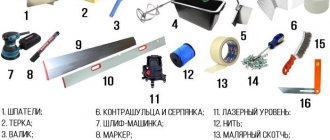VMTEC pumps (Germany)
PRIMA VMEV 3PRIMA VMEV 5PRIMA VMEV 9PRIMA VMEV 16 Output: up to 4.5 m³/hour Head: up to 254 m Output: up to 7 m³/hour Head: up to 254 m Output: up to 14 m³/hour Head: up to 240.5 m Output: up to 25 m³ /hour Head: up to 195.5 mPRIMA VMEV 30PRIMA VMEV 45PRIMA VMEV 65PRIMA VMEV 95 Output: up to 45 m³/hour Head: up to 319.5 m Output: up to 65 m³/hour Head: up to 309.5 m Output: up to 90 m³/hour Head : up to 227 mFlow: up to 120 m³/hour Pressure: up to 187 mPerformance characteristics
- Flow (flow, productivity, throughput) - the volume of liquid that the pump is capable of pumping over a certain time (measured in m³/h, l/h, l/min). Depending on the model, vertical pumps from Grundfos have a capacity of up to 85-200 m³/h.
- The pressure characterizes the maximum distance over which the equipment can pump liquid. It is selected taking into account the length, bends of the line and the pressure in it. The pressure of vertical centrifugal devices from Grundfos is up to 238-400 meters (depending on the model).
- Working temperature. This parameter indicates the permissible temperature of the pumped liquid.
Grundfos pumps
CR 1sCR 1CR 3CR 5 Output: up to 0.8 m³/hour Output: up to 1 m³/hour Head: up to 172 m Output: up to 3 m³/hour Head: up to 176 m Output: up to 5 m³/hour Head: up to 176 mCR 10CR 15CR 20CR 32 Output : 10 m³/hour Output: 15 m³/hour Output: 20 m³/hour Output: 32 m³/hour CR 45CR 64CR 90CR 120 Output: 45 m³/hour Output: 64 m³/hour Output: 90 m³/hour Output: 120 m³/hour CR 150 Output: 15 0 m³/hourCRE 1CRE 3CRE 5CRE 10Output: 1.2 m³/hourOutput: 3.6 m³/hourOutput: 6 m³/hourOutput: 12 m³/hourCRE 15CRE 20CRE 32CRE 45Output: 18 m³/hourOutput: 24 m³/hourOutput: 38 m³/hourOutput: 54 m³ /hourCRE 64CRE 90CRE 120CRE 150Output: 77 m³/hourOutput: 108 m³/hourOutput: 140 m³/hourOutput: 180 m³/hourA little history
The simplest pumps have been known since before our era. But the idea of using centrifugal force in the process of pumping water appeared to Leonardo da Vinci at the turn of the 15th-16th centuries, but only in sketches. It is not known for certain when exactly a full-fledged centrifugal pump was developed, so no one can name a single inventor.
At the beginning of the 17th century, the Frenchman Blancano built the simplest possible installation that could supply water using a rotating impeller. A centrifugal pump with a four-blade impeller located in a volute casing was first proposed by the Frenchman Denis Papin at the end of the 17th century. The first vertical centrifugal pump design was tested and introduced by engineer Le Demur in the first half of the 18th century, and the classic wheel shape appeared only at the beginning of the 19th century. Centrifugal pumps became widely used after they began to be equipped with an electric motor.
Russian and foreign inventors have been working independently on the creation of full-fledged units for decades.
The design of a vertical pump with several stages appeared at the turn of the 19th-20th century thanks to our compatriot, the Russian engineer Pushechnikov. His pumping unit could pump water from wells up to 250 meters deep.
Features and scope of application of vertical pumps
A considerable number of types of pumps have both horizontal and vertical versions. Despite the fact that pumps can vary greatly in design and application from type to type, the features of the vertical arrangement allow us to highlight common features for all vertical pumps.
One of the advantages, which in some cases can be decisive, is the reduction in the area occupied by the pumping unit. If we are talking about an industrial premises, then in this case there is unlikely to be a need to save the area available for placing the pump by complicating its design. However, cases when the pump needs to be placed in conditions of limited space are common. For example, this could be the hold of a ship or the space inside the hull of a large unit.
Another area where vertical pumps is pumping liquids from tanks, barrels or artificial and natural reservoirs. In particular, vertical pumps are submersible and semi-submersible pumps, as well as barrel pumps as a special case of semi-submersible. The vertical design for these types of pumps allows them to be positioned so that the drive is located above the liquid level, thereby avoiding the need to provide increased insulation, and the working element below the liquid level. This ensures the operating conditions of the pump under the fill. Otherwise, when using a conventional horizontal pump, the hydraulic machine would be required to have self-priming, but not all types of pumps have this ability, or providing such an ability is associated with additional complication, and therefore an increase in the cost of the pump.
Another example of rationalization through the use of vertical pump designs is inline pumps (from the English inline, that is, built into a line). Typically of a centrifugal type, these pumps have the same axes of inlet and outlet pipes, which allows them to be built directly into an existing pipeline using flange connections, without resorting to the use of additional pipes and connections. The vertical design of these pumps optimizes available space and makes installation and maintenance easier.
The vertical placement of the pump poses a number of technical and operational challenges, which, however, are offset by the overall efficiency of the pump. The vertical arrangement of the shaft in most cases requires additional stability and compensation of axial forces, for which purpose thrust or angular contact bearings are used instead of radial ones. The bearing lubrication system is also undergoing changes. In the case of semi-submersible pumps, their design is further strengthened by a frame that supports the elements of the machine and is mounted on a supporting horizontal surface (barrel lid, well hatch, etc.)
How are centrifugal pumps classified?
Centrifugal vertical pumps and all centrifugal products are classified according to:
- The number of wheels they come in is:
- single-stage with one wheel, which can be cantilever;
- multi-stage, with a large number of wheels.
- Pressure is distinguished:
- with low pressure up to 2 kgf/cm2;
- with an average pressure from 2 to 6 kgf/cm2;
- with high pressure, which is more than 6 kgf/cm2.
- Method of supplying water to the impeller. The water supply to the impeller can be:
- with one-way liquid inlet;
- double suction, when water is supplied from both sides.
- Shaft location. Centrifugal pumps are:
- horizontal;
- vertical.
- Housing connector. The housing connector is:
- horizontal;
- vertical.
- The method of draining liquid from the impeller into the spiral channel of the pump housing:
- spiral centrifugal pumps, in which the liquid is discharged directly into a spiral channel;
- turbine Here, before entering the spiral channel, the liquid must pass through a special device, which is a guide apparatus consisting of a stationary wheel with blades.
- Impeller rotation speed levels:
- slow-moving;
- with normal rotation speed;
- high-speed devices.
- Type of liquid pumped by the pump:
- plumbing;
- sewer;
- alkaline and acidic;
- dredgers;
- oil and others.
- Method of connection to the motor:
- driven, with a pulley or gearbox;
- connection via a coupling.
The kit with centrifugal pumps should include:
- A receiving check valve with a mesh, which is necessary to retain water in the pump suction pipe and housing when filling it before starting, and the mesh should retain large suspensions floating in the water.
- Valve.
- A vacuum gauge used to measure the vacuum on the suction side. The device is placed on a water pipe between the valve and:
- device body;
- a tap through which air is released during filling is placed in the upper part of the body;
- on the pressure pipeline with a check valve that prevents water from entering through the pump when another pump is operating in parallel, in the opposite direction.
- A valve on the pressure pipeline, which is necessary for starting, stopping and adjusting the pressure and productivity of a centrifugal pump.
- A pressure gauge for measuring the pressure on the pressure pipe, which is developed by the pump.
- The safety valve, located behind the valve on the pressure valve, serves to protect the pressure pipe, pipeline and the pump itself from water hammer.
- Device for filling the pump with water.
Tip: When purchasing a centrifugal pump, you need to make sure that all components are available, according to the attached operating instructions, and check the serviceability of the device.
Areas of use
This type of centrifugal pump is designed for pumping the following liquids:
- Water (any temperature).
- Liquids with high viscosity.
- Wastewater.
- Liquids that contain various impurities (sand, soil, peat, etc.).
Due to the ability of the pumps to pump such a variety of liquids, they are extremely popular and are used in different areas, for example:
- Chemical industry.
- Oil production and oil refining industry.
- Chemical field.
- Household needs.
- Utility services.
Main advantages
Advantageous characteristics of pumps
The popularity of pumps is associated with their inherent advantages that are not characteristic of other types of similar equipment:
- Constructive. The design feature of single-stage centrifugal units lies in its compactness (the unit is connected directly to the electric motor and steam turbine).
Conclusion. Thanks to this, the pumps are lightweight and have compact overall dimensions. In addition, one cannot fail to mention the high performance of the units. There is no need for a large area to install them. The process of their installation and dismantling is simple and does not require a lot of time.
- Functional. They consist in simplicity and accessibility of configuration and bringing to working condition. You can adjust the equipment yourself without the involvement of specially trained specialists.
- Low price. The creators managed to achieve low cost of equipment through the use of inexpensive materials (polymers, alloys of steel and cast iron).
- Strength. The single-stage centrifugal pump is designed in such a way that it is suitable for long-term operation, and due to the high strength of its working elements, it has a long service life.
Note. These factors make it possible to avoid unnecessary material costs for its in-line repair, as well as to avoid downtime of the production process during its repair.
High performance. It is safe to say that this factor is one of the determining factors in the popularity of the units. The maximum productivity reaches 2.5 000 m3/hour.
Dredgers
Dredgers are used to pump mixtures of loosened soil and liquid through pipes to the required distance. Today, the market produces pumps with a transportation range of up to 5 km and a capacity of 40 to 1200 cubic meters per hour. With the help of dredgers, it is possible to develop excavations up to 15 m deep below the water horizon. These installations have a number of features due to the high concentration of large particles in the pumped water mass. For this reason, a wear-resistant wheel is created from manganese hard steel.
The single-stage vertical centrifugal pump is protected by armor on the inside of the housing to prevent rapid wear. To prevent the mechanism from becoming unusable so quickly, purified water is supplied between the wheel into the left cavity and to the oil seal through special drillings to flush out solid fragments from these places.
Radial blades are installed on the outer part of the working and covering wheel disks. They are selected so that the axial amplifier comes into balance during rotation.
Correct operation is the key to long service life
Failure-free operation of centrifugal pumps can be ensured by organizing the required operating conditions for the equipment and installing monitoring devices. A valve and an appropriate filter will help protect the impellers from foreign bodies. A check valve with a pressure gauge that determines the pressure at the inlet pipe will help avoid the occurrence of cavitation processes.
A pressure gauge that records the pressure inside the pump will help prevent water hammer.
When choosing vertical centrifugal units, you should focus on their characteristics. The most important parameters are:
- power consumption;
- performance;
- water jet pressure at the outlet;
- external dimensions;
- material for the manufacture of the flow part and working parts that come into contact with the pumped liquid.
The lifespan of pumping equipment largely depends on its correct use. Vertical pumps should not be installed in an inclined position, much less in a horizontal position. They are strictly not allowed to be used for pumping media not specified in the instructions. The water pump will not withstand the action of aggressive or viscous liquid; it must not be installed in drainage systems where solid particles may be present. But it makes no sense to purchase expensive chemical pumps for watering your garden.
If pumping equipment is used in winter, it will need to be insulated or installed in a heated room. Otherwise, the housing may depressurize and even burst.
Compliance with operating rules will help prolong the full operation of any centrifugal pumps, including vertical ones.
This is interesting: Centrifugal pumps: design, principle of operation, advantages and disadvantages

